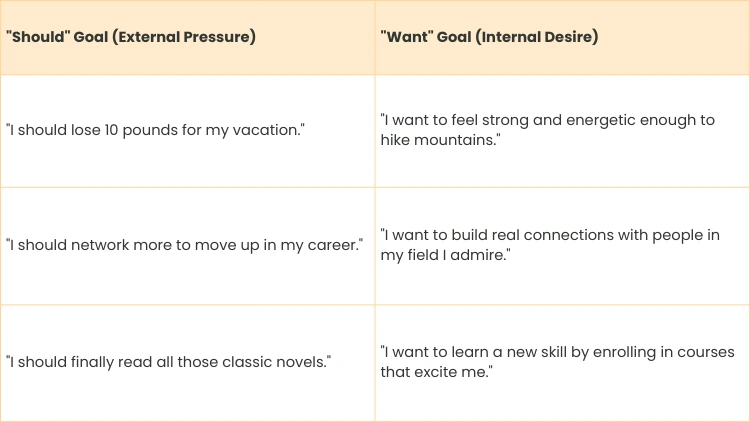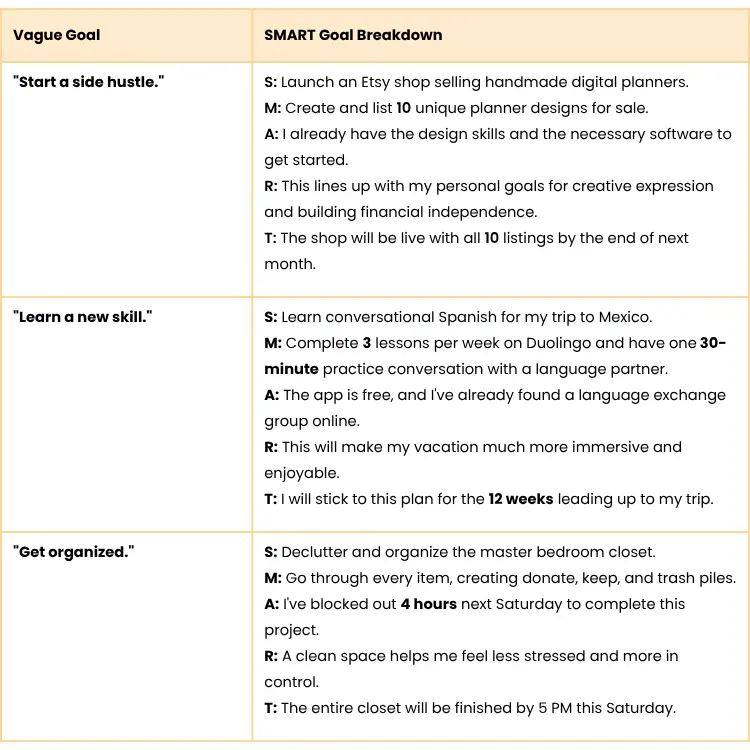How to Set Personal Goals: Achieve Your Dreams Today

Setting personal goals is all about turning those daydreams into actual, concrete plans. The secret sauce? It’s a mix of deep personal alignment, crystal-clear specifics, and a system that actually gets you moving. This is how you go from a fuzzy idea like "be healthier" to taking specific actions that create real, lasting change.
Jump To Section

Earn As You Learn
Earn 25% commission when your network purchase Uplyrn courses or subscribe to our annual membership. It’s the best thing ever. Next to learning,
of course.
Why Most Goals Fail Before February
We've all been there. That first rush of excitement for a new goal often fizzles out way faster than we'd like. The real problem usually boils down to a massive disconnect between our grand ambitions and our day-to-day reality. We set goals that sound impressive but have no personal meaning or a practical path to get there.
Think about a common one: "be more present". It’s a fantastic intention, but it’s doomed from the start because it's an abstract concept, not something you can actually measure. What does being "more present" even look like for you, minute by minute? Without the specifics, you have no way to track your progress or even know if you're pulling it off.
The Ambition and Reality Gap
This gap—the one between what we want and what we do—is where most goals go to die. The statistics are pretty telling. People who actually set goals are 10 times more likely to achieve them. And yet, a mind-boggling 92% still fail to hit their targets.
So what's the difference maker? It's all about structure. Research shows that setting specific goals boosts motivation by 44%, and breaking them down into smaller tasks makes you 50% more likely to succeed. You can find more goal-setting statistics and insights on zipdo.co.
A goal without a plan is just a wish. The most effective way to set personal goals is to build a bridge between your big-picture vision and your daily actions. This means transforming those vague ideas into concrete, actionable steps that fit into your life as it is right now.
Reframing your approach is everything. Instead of clinging to a vague desire, you need a tangible action plan. For instance, that goal to "be more present" could be transformed into this:
- Action 1: Put my phone in another room from 6 PM to 8 PM on weeknights to focus on family.
- Action 2: Do a 10-minute guided meditation every morning before I even think about checking email.
- Action 3: Schedule one walk a week with no devices, just to observe my surroundings.
Suddenly, an abstract wish becomes a clear, actionable system. This is the fundamental shift you need to make goals that actually stick. Recognizing that even the best intentions need a solid framework is the first step. Understanding why planning does not work without the right system in place can give you an even deeper perspective on this.
Find Your 'Why' Before Your 'What'
Before you even think about writing down a single goal, we need to talk about what actually drives you. It’s so tempting to jump straight to the "what", but without a solid "why", you’re just planning a road trip without a destination. Sure, you'll be moving, but you'll probably end up somewhere you never wanted to be.
The goals that actually stick are the ones that are extensions of our core values. They're not just items on a to-do list. When a goal is disconnected from what you truly care about, it feels like a chore, and it’s the first thing you'll drop when life gets messy. This is exactly where most people stumble.
Conduct a Personal Values Audit
To make sure your goals have real staying power, you need to conduct a quick "Values Audit". This isn't some soul-searching epic; it's a practical look at your non-negotiables in the big areas of your life. All it takes is asking a few honest questions.
Think about a common goal, like getting a promotion. Is the new title the real prize? Or is the deeper driver a need for creative autonomy, a craving for financial security, or maybe the desire for public recognition? Getting to that root motivation is everything.
Here are a few questions to get the ball rolling:
- Career: What parts of my job leave me feeling energized instead of drained? Is it working with a team, solving complex puzzles on my own, or having the freedom to lead?
- Health: When I imagine my healthiest self, what's the feeling I'm really after? Is it boundless energy, unshakeable confidence, or a sense of inner calm?
- Relationships: What do I value most in the people I'm close to? Deep conversations, shared adventures, or just knowing we have each other's backs?
Answering these questions helps you tune out the noise of what society says you should want and tune into what your internal compass is telling you. You can dig deeper into how to identify your values in order of priority and build from there.
When a goal is rooted in your values, it becomes part of your identity. It’s not just something you do; it’s a reflection of who you are. That connection is the fuel that will get you through the tough spots when the initial excitement fades.
For instance, someone who deeply values "adventure" might set a goal to save money for a backpacking trip. But another person who values "stability" could use that exact same money to build an emergency fund. The action is the same—saving money—but the why provides the personal, lasting motivation.
Distinguishing "Should" Goals from "Want" Goals
"Should" goals are the ones we inherit from the outside world—what our parents expect, what we see on social media, or what's considered "normal" on our career path. They look great on paper but have no personal fire behind them.
"Want" goals, on the other hand, bubble up from a place of genuine desire. They click perfectly with your values.
Seriously, take a moment to find your "why". It's the foundational step that ensures the goals you set will bring you real fulfillment, not just a fleeting sense of accomplishment.
Here’s a quick way to spot the difference:

How to Craft Goals Using the SMART Framework
So you've figured out your "why"—the deep-seated reason you want to make a change. Awesome. Now it's time to build the "what". This is where a fuzzy dream gets hammered into a solid, workable plan.
And for that job, the best tool in the shed is the SMART framework.
It’s a deceptively simple system that forces you to get real about what you want to achieve. Instead of a vague wish, you'll walk away with an actual roadmap. The framework breaks your big ambitions down into five critical parts: Specific, Measurable, Achievable, Relevant, and Time-bound.
As you can see, a successful goal isn't just one big idea. It’s a series of clear, structured actions that build on each other, creating the momentum you need to actually follow through.
Breaking Down Each SMART Component
Let's unpack what these five letters really mean. Think about common goals like "get fit" or "save more money". They sound nice, but they’re where good intentions go to die because they lack any real direction.
- Specific: You have to be crystal clear. "Get fit" is a wish. "Complete a 12-week strength training program by working out three times a week at the downtown gym" is a target.
- Measurable: How will you know you're making progress? You need numbers. For that fitness goal, you could log every workout. If you want to "read more", make it measurable: "Read 20 pages of a non-fiction book every night before bed".
- Achievable: Your goal needs to stretch you, not break you. If you haven't run since high school, signing up for a marathon next month is just setting yourself up for failure. A 5km race in three months, though? That’s a challenge you can actually conquer.
- Relevant: This is where you reconnect with your "why". Does this goal actually matter to you and fit into the life you want? If your core value is "family connection", a goal that requires you to work 80-hour weeks might not be relevant right now. You can dig deeper into this alignment using the Wheel of Life model.
- Time-bound: Every goal needs a finish line. A deadline creates a healthy sense of urgency and kills procrastination. "I will run my 5km race on June 15th". Done.
This isn't just feel-good advice. Decades of research on Goal Setting Theory backs this up. One foundational study found that a staggering 80% of people perform better when they have clear, challenging goals versus vague ones like "do your best".
For an even smoother planning process, well-designed goal planning templates can give you the structure you need to get all these details down on paper.
Transforming Vague Ideas Into SMART Goals
Seeing this in action is the best way to grasp its power. Let's take a few common, fuzzy goals and run them through the SMART filter to show the before and after.
By applying this simple structure, a big, intimidating idea like "start a side hustle" transforms into a tangible project with a clear finish line. It's no longer just floating around in your head—it's a series of manageable steps you can start chipping away at today.

Create Your Roadmap from Goal to Daily Action
A perfectly crafted SMART goal is a fantastic start, but it’s still just a destination on a map. To actually get there, you need to build the roads. This is where we reverse-engineer your big ambition into small, repeatable daily actions that feel almost effortless.
This process is all about breaking things down until they're no longer intimidating. Goals don’t fail because they're too big; they fail because the first step feels like a giant leap. The secret is to shrink that first step until it’s too small to fail.
Deconstruct Your Goal Into Milestones
Start by looking at your time-bound deadline and work backward. If your goal is to launch an Etsy shop in three months, what really needs to happen each month to stay on track? Suddenly, one giant project becomes three smaller, more manageable ones.
This simple act immediately clarifies your priorities and stops that "where do I even begin?" feeling of overwhelm. You're not just "building a business"; you're tackling specific, sequential milestones.
- Quarterly Milestones: Think of these as the major phases of your project. For the Etsy shop, Month 1 might be product creation, Month 2 could be photography and listing, and Month 3 is all about the launch and promotion plan.
- Weekly Tasks: Now, break each monthly milestone into weekly objectives. For Month 1 (Product Creation), a weekly task might be "Finalize five digital planner designs". See how much clearer that is?
- Daily Actions: This is where the magic really happens. What's the one small thing you must do today to complete your weekly task? It might be as simple as, "Design the cover page for one planner". This is the bite-sized action that builds unstoppable momentum.
Choose Your System and Make it Visible
Once you have your daily actions defined, you need a system to keep them front and center. Honestly, the tool you use is way less important than your consistency in using it. Your goal is to offload the mental burden of remembering what to do next so you can focus all your energy on doing.
A great system makes your next step obvious.
- Digital Tools: A Trello or Asana board is perfect for visualizing your entire roadmap. You can set up columns for milestones, weekly tasks, and daily to-dos and literally drag your progress across the board.
- Simple Calendars: Block out time in your Google Calendar for your daily actions. For example, schedule "Write for 30 minutes" every weekday at 8 AM. When you treat it like an important appointment, you're far more likely to follow through.
- Physical Notebooks: There's real power in the simple act of writing down your goal and daily tasks. It solidifies your commitment. If you're going this route, check out this guide on how to create a to-do list that actually works for you.
The point of a roadmap isn't just to plan; it's to create a system where consistent, small actions become automatic. It’s about building a habit of progress, one tiny step at a time.
As you define these daily actions, it’s crucial to understand the principles behind building healthy habits that actually stick. Why? Because your daily actions are the habits that will ultimately determine your outcome. This approach transforms a daunting goal into a simple, daily routine.
How to Stay Motivated When Progress Feels Slow
That first burst of energy when you set a new goal is incredible. But what happens a few weeks or months down the road, when the novelty has worn off and the finish line feels just as far away as when you started? This is the exact point where most people get tripped up. It’s usually not because the goal was wrong, but because their motivation system wasn't built for the long haul.
Lasting motivation isn’t about hype. It's about resilience. It’s about building a framework that can carry you through the inevitable slowdowns and roadblocks. The real secret is shifting your focus away from the huge final outcome and onto the consistency of your daily effort.
Conduct Regular Progress Reviews
One of the best ways to keep yourself in the game is to schedule regular "progress reviews". Think of these as quick check-ins, not performance evaluations. The point isn't to judge yourself but to acknowledge your effort and, most importantly, celebrate the small wins. These little victories are absolute rocket fuel for your morale.
Let's say your goal is to save $5,000 for a down payment over ten months. Don't just wait until the end to see how you did. A monthly review might show you saved $510 instead of the planned $500. That extra $10 is a win. It’s proof that your system is working and gives you a tangible reason to keep pushing.
Treat Setbacks as Data, Not Defeat
Here's a hard truth: progress is never a straight line. You will have off-weeks. You’ll miss a workout, break a good habit, or fall short of a weekly target. What truly matters is how you respond. Instead of spiraling into feelings of failure, try looking at it as valuable data.
A setback is simply feedback in disguise. It’s your journey telling you that something in your strategy needs a small adjustment. It’s an opportunity to learn and refine your approach, not a reason to quit.
Ask yourself what really happened. Was your daily action a little too ambitious? Did something unexpected throw you off course? For example, if you missed two workouts, was it because you scheduled them at 5 AM but you're not a morning person? The data suggests you should move them to lunchtime instead. Use that information to adjust your plan for the week ahead. A common reason for stalling is procrastination, which often means a task feels too big or overwhelming. Learning how to overcome procrastination can be a complete game-changer for getting your momentum back.
Build a Support and Accountability System
Trying to do it all on your own is incredibly tough. Sharing your goals with a trusted friend, partner, or family member can make a world of difference. An "accountability partner" isn't someone who scolds you; they're your personal cheerleader who checks in, offers encouragement, and reminds you of your "why" when you're tempted to give up.
Even the simple act of writing your goals down is a powerful first move. Studies consistently show that people who write down their goals are significantly more likely to achieve them—some reports say as much as 4.2 times more likely. Yet, only about 14% of adults have clear, written goals. That’s a huge gap between what we want and what we do to get there.
Here are a few ways to build your support network:
- Schedule weekly check-ins: A quick five-minute call or text with your accountability partner can be all it takes to reignite your focus.
- Use technology: Habit-tracking apps like Streaks or Habitify create a visual chain of your progress. It's surprisingly satisfying to see those chains grow and not want to break them.
- Join a community: Look for an online group or a local club with people pursuing similar goals. There's a powerful, motivating energy that comes from being part of a pack.
By putting these strategies into practice, you start building a resilient system that doesn’t rely on fleeting inspiration. You learn to ride the waves, celebrate the small steps, and keep moving forward—even when progress feels painfully slow.
Your Questions on Goal Setting Answered
Even with the best game plan, you're going to have questions. Hurdles are just part of turning big ambitions into your new reality. This is where we get into the weeds and tackle those common "what ifs" that pop up along the way. Getting these answers straight gives you the confidence to handle whatever the journey throws at you.
What if I Have Too Many Goals at Once?
Ambition is a great thing, but focus is what gets you across the finish line. Trying to chase five huge goals at the same time is a classic recipe for burnout. Your energy and attention get spread so thin that you don't make any real headway on any of them.
This is a good time to revisit those self-reflection exercises we talked about earlier. Get ruthless and prioritize the one or two goals that feel most vital right now.
A strategy I love is adopting a "focus theme" for each quarter. For instance, you could decide 'Q1 is all about Health'. You'd pour your primary energy into that, while just keeping your other, smaller goals on a low simmer. This way, you're always moving forward without completely overwhelming your system.
The point isn't to do everything at once. It's to make real, focused progress on what matters most. That’s how you build the momentum that keeps you going when things get tough.
How Often Should I Review My Progress?
You need a rhythm for checking in, but it shouldn't feel like a chore. The best systems I've seen are layered, and consistency is always more important than the exact schedule.
Here’s a simple, effective cadence you can try:
- Daily Intention (5 Minutes): First thing in the morning, identify the single most important thing you can do today to push your goal forward. It sets a crystal-clear focus for the day ahead.
- Weekly Review (20 Minutes): Block out a little time every week, maybe Friday afternoon, to look back. What went well? Where did you get stuck? What are the key priorities for next week?
- Monthly Check-in (1 Hour): This is your big-picture session. Are you still heading in the right direction? Does this goal still light you up? This is your chance to zoom out and make any major course corrections.
What Should I Do if I Fall Completely Off Track?
First things first: take a breath and drop the guilt. Everyone falls off track. It’s not a moral failing; it’s an inevitable part of doing anything hard. The people who ultimately succeed aren't the ones who never stumble—they're the ones who learn to get back up quickly.
Instead of beating yourself up, get curious. Ask why you fell off.
Was the goal too big? Was the next step too intimidating? If so, break it down into something almost laughably small just to get moving again. For example, if your goal was to write 500 words a day and you haven't written in a week, make the new goal "write one sentence". The point is to restart the habit. Sometimes your priorities genuinely shift, and that’s okay too. It is perfectly fine to adjust, pivot, or even abandon a goal that no longer serves your "why". The real objective is sustainable progress, not just rigidly sticking to a plan that doesn't fit anymore.
Ready to turn your personal and professional ambitions into achievable realities? At Uplyrn, we provide the expert-led courses and supportive community you need to build the skills that will get you there. Start your learning journey and achieve your goals faster by visiting Uplyrn today.


Leave your thoughts here...
All Comments
Reply